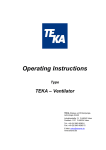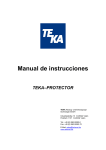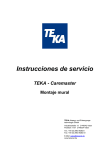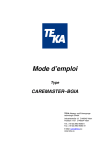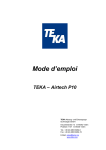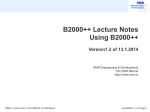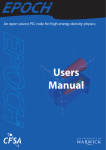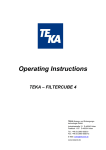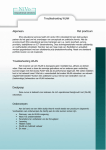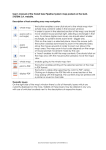Download Operating Instructions
Transcript
Operating Instructions Typ Extractor Blower TEKA Absaug- und Entsorgungstechnologie GmbH Industriestraße 13 D-46342 Velen Postfach 1137 D-46334 Velen Tel.: +49 (0) 2863 9282-0 Fax: +49 (0) 2863 9282-72 E-Mail: [email protected] www.tekanet.de List of contents 1. Diagrams / description of the elements........................................................................................... 3 2. Foreword ....................................................................................................................................... 5 3. Function of the TEKA – Extractor blower........................................................................................ 6 4. Safety instructions ......................................................................................................................... 6 5. Initial operation .............................................................................................................................. 7 5.1. Connection of the appliances .................................................................................................. 7 6. Technical data ............................................................................................................................... 8 7. Declaration of conformity for TEKA – extractor blower.................................................................... 9 BA_Sauggebläse_091216_GB.doc 2 16.12.2009 1. Diagrams / description of the elements Ventilator made of silumin cast iron Pos.1 Pos.2 Pos.3 Pos.4 Motor protective switch Switches the ventilator on or off Ventilator frame Motor Ventilator housing BA_Sauggebläse_091216_GB.doc Pos.5 Pos.6 Pos.7 Pos.8 3 Clamping lock Protective grid Castor with brake Castor without brake 16.12.2009 Ventilator made of sheet steel Pos.1 Pos.2 Pos.3 Pos.4 Motor protective switch Switches the ventilator on or off Mounting profile Motor Ventilator housing BA_Sauggebläse_091216_GB.doc Pos.5 Pos.6 Pos.7 Pos.8 Pos.9 4 Exhaust stub Protective grid Intake stub Castor without brake Castor with brake 16.12.2009 2. Foreword One sector of extraction equipment has become very significant in recent years. The filtering of extracted pollutants and the recycling of filtered air to the working area. This is surely a sign that the environmental consciousness of every one of us has altered very strongly in favour of our environment. For a long time now, no one has denied that pollution occurs during production. However, the pollutants depend on the process that is used. One can basically distinguish between gases and fumes (smoke). Fumes could also really be described as dust. If you examine this dust under a microscope, you will find that they consist of very fine particles, often with a size of 1 µm or smaller, that can enter the lungs. The classical method of trying to improve the working conditions of polluted workplaces is general ventilation. In this case, the general rule is a multiple change of air in the workshop, i.e. the complete volume of air in the workshop is replaced. However, this method only achieves a small reduction in the level of pollution within the breathing space of the user. The same applies to “overhead” extraction, i.e. the installation of large extractor hoods above the workplaces. This is the worst airflow imaginable, since the pollutants first pass through the breathing space of the user, and only afterwards are they contained and extracted. This is surely not the point of the exercise. A much more effective method than overhead/wide-area extraction is the removal of pollutants directly at their source, with localised extraction. Both the investment and the operating costs are substantially lower if localised extraction is used. The environmental and workplace-safety measures are especially important requirements for successful application of a technology, in addition to the technological optimisation of the processing method. In a time of increasing sensitivity and tougher legislation, the task therefore lies in making an early assessment of the potential hazards for the workplace and the environment, and reducing them as appropriate. BA_Sauggebläse_091216_GB.doc 5 16.12.2009 3. Function of the TEKA – Extractor blower The TEKA – Extractor blower filter unit is primarily used for localised extraction of welding fumes. For this purpose, the unit can be equipped with one flexible extractor hose or application-specific fittings. Limits of application: welding fumes with oil mist, aluminium dust, grinding dust, extraction of metallic dust, gases, water etc. (If you are uncertain, please contact the manufacturer!) The polluted air is sucked into the extractor hood (or application-specific fitting) and transported outside through the extractor hose. 4. Safety instructions When using electrical equipment, the following basic safety rules must be observed, for protection against electric shock, injury, or fire hazards. • Before using the equipment, read and observe these instructions! • Keep the operating and maintenance instructions in a safe place! • Never use the extractor blower to extract easily inflammable or explosive gases! • Never use the extractor blower for extracting aggressive media! • Never use the extractor blower for extracting burning or glowing materials • Never use the equipment to suck up any kind of liquid! • Do not use the equipment for the extraction of organic substances without written approval from the manufacturer! • Protect the connectors against heat, moisture, oil, and sharp edges! • Pay attention to the permitted supply voltage! (Observe the data on the nameplate!) • Only use TEKA spare parts! • The exhaust vent must not be covered up or blocked! • Always make sure that the unit is securely mounted! • The mains supply cable for the unit must be checked regularly for possible damage! • The extractor blower must not be used if the mains supply cable is not in perfect condition! • Do not use the extractor blower if one or more of its components are faulty, missing, or damaged. In any of these cases, please call the TEKA service department on ++44-(0) 28 6392 82-0. BA_Sauggebläse_091216_GB.doc 6 16.12.2009 5. Initial operation The extractor blower is supplied with all connections. The extractor blower can be used in any location. The extractor blower may be installed outdoors. The extractor fittings and possible other accessory equipment, must be installed or mounted on the extractor blower before initial operation. Warning: The extractor blower may only be operated without a hose if the intake and exhaust stubs are secured by a grid! 5.1. Connection of the appliances • Connect the extractor blower with the power supply. (Observe the information on the nameplate!) Warning: Work on the electrical sections must only be carried out by qualified and authorized personnel. (Observe the data on the nameplate!) BA_Sauggebläse_091216_GB.doc 7 16.12.2009 6. Technical data Warning: Observe the information on the nameplate! Motor power kW Voltage V Frequency Hz Rated current A Max. airflow volume max. m³/h Protection class ISO class 0.75 230 50 2.96 2000 IP 54 F 0.75 400 50 1.71 2000 IP 54 F 0.75 500 50 1.41 2000 IP 54 F 1.1 230 50 4.2 2500 IP 54 F 1.1 400 50 2.4 2500 IP 54 F 1.1 500 50 2.1 2500 IP 54 F 1.5 230 50 5.9 3000 IP 54 F 1.5 400 50 3.8 3000 IP 54 F 1.5 500 50 2.68 3000 IP 54 F 2.2 230 50 8.3 3500 IP 54 F 2.2 400 50 4.8 3500 IP 54 F 2.2 500 50 3.6 3500 IP 54 F 3.0 400 50 6.4 4000 IP 54 F 3.0 500 50 4.9 4000 IP 54 F BA_Sauggebläse_091216_GB.doc 8 16.12.2009 7. Declaration of conformity for TEKA – extractor blower TEKA Absaug - und Entsorgungstechnologie GmbH Industriestraße 13 D - 46342 Velen Phone:+49 2863 92820 Fax:+49 2863 928272 e-Mail: [email protected] Internet:http://www.tekanet.de We herewith declare in sole responsibility that the afore-mentioned product, starting from machine No.: 110000000, conforms to the following standards: Directives on machine building: Electromagnetic compatibility: Directives on printing device: Directives on low voltage: 2006/42/EG 2004/108/EG 97/23/EG 2006/95/EG Applied harmonised standards: - DIN EN 349 DIN EN 983 DIN EN 12100 part 1 and npart 2 DIN EN 60204 part 1 DIN EN ISO 13857 DIN EN ISO 14121 plus further national standards and specifications: - DIN 45635 Part 1 This declaration will become void if changes are effected to the suction and filter systems which were not agreed upon in writing by the manufacturer. Velen, 16 December 2009 TEKA Absaug - und Entsorgungstechnologie GmbH BA_Sauggebläse_091216_GB.doc 9 16.12.2009









